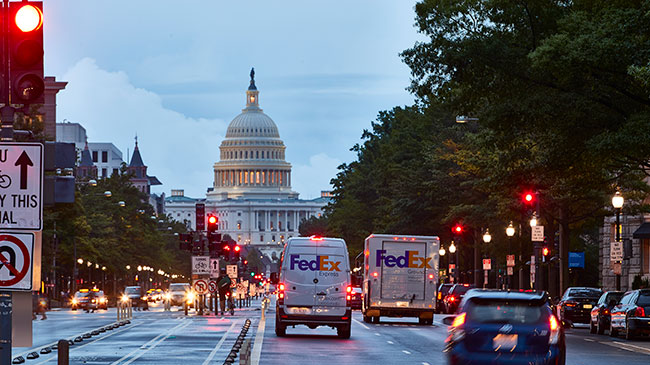
How to ship to Canada
Shipping goods to Canada is often easier than shipping to other countries as the paperwork is quite straightforward. The Canada Border Services Agency (CBSA) also provides many online resources to help you understand the import process.
What documents do I need when shipping goods to Canada?
When shipping to Canada from the US, or any other country, an air waybill, commercial invoice and packing list are often enough to clear most goods through Canadian customs. Make sure to check that the information on them is correct and complete.
High-value commercial shipments can be harder to clear than other goods. However, the CBSA has a handy step-by-step importing guide, where you can learn about the import process from start to finish.
The goods description on the commercial invoice
A clear and accurate goods description on the commercial invoice and air waybill helps Canadian customs to classify goods correctly and clear them quickly. This includes an accurate HS Code so the right duties and taxes can be applied. It's also important to avoid vague descriptions such as 'gift', 'samples' or 'parts'.
The commercial invoice should be written in English. The receiver's contact information (both email and phone number) should be included on both the commercial invoice and air waybill so they can be contacted if necessary.
How will my shipment clear customs in Canada?
The customs procedure that applies to your shipment will be determined by the details provided on the shipping paperwork, such as goods value, as well as by additional screening during customs clearance.
The CBSA has three customs clearance procedures for shipments entering Canada:
Courier Imports Remission Order (CIRO) - Informal clearance
Shipments of unregulated goods valued at less than CAD $20 pass Canadian customs quickly through a type of informal clearance known as Courier Imports Remission Order (CIRO).
Low Value Shipment Program (LVS) - Informal clearance
Shipments of unregulated goods with a value between CAD $20.01-$3,300 are processed by the Low Value Shipment Program (LVS).
High Value Shipment Program (HVS) - Formal clearance
Shipments of regulated goods, or goods with a value above CAD $3,300, are processed through the High Value Shipment Program (HVS). This formal clearance procedure requires additional shipping documentation.
Customs clearance in Canada
An overview of the three types of customs clearance in Canada:
Informal Clearance |
Formal Clearance |
|
|---|---|---|
Eligible shipments and values |
|
|
Required documentation |
|
Additional documents such as:
|
Canada's trade agreements
Canada has trade agreements with many countries, which are created to reduce import tariffs and duties on international commercial shipments, and to make the shipping process easier. Some of Canada's trade agreements include:
- USMCA/CUSMA with the US and Mexico from July 1, 2020 (previously NAFTA)
- CETA with the EU
- EFTA with Iceland, Lichtenstein, Norway and Switzerland
- CPTPP with Australia, Brunei, Chile, Japan, Malaysia, Mexico, New Zealand, Peru, Singapore and Vietnam
- Individual FTAs with Costa Rica, Colombia, Peru, Panama and other countries
Visit the CBSA origin of goods page to see if a trade agreement may apply to your shipment, and what proof of origin document or form is required.
Do I need to provide additional documents for customs clearance in Canada?
Commercial shipments of high-value goods, or regulated goods, may require extra documentation to pass customs clearance in Canada. Some common documents that might be required include:
- The receiver’s Canadian Business Number (BN) – issued by the Canada Revenue Agency (CRA), to be written on the commercial invoice
- Proof of origin – check the CBSA origin of goods to see what proof of origin document the sender needs to provide. If unsure, check with your carrier.
- Additional licenses, certificates or (import) permits – from the receiver, for the import or sale of regulated goods in Canada. The government agency that issues these documents depends on the goods being shipped. See the CBSA list of Canadian government agencies and the product groups they are responsible for.
- Customs broker documents – if the receiver is using a broker, either through the carrier or separately, they’ll need to sign a general agency agreement (GAA) and power of attorney (POA). These documents are required for all importers, regardless of the nature of the goods being shipped or the amount of duties and taxes payable. There are three types of general agency agreements:
- Canadian agency agreements – between Canadian importers and brokers
- US non-resident importer (NRI) agreement – for US companies doing business in Canada
- Overseas non-resident importer (NRI) agreement – for foreign companies doing business in Canada
- Canadian agency agreements – between Canadian importers and brokers
Taxes and ancillary fees on imported goods in Canada
When shipping commercially to Canada it's important to be aware of duties, taxes and ancillary charges that contribute to the total cost of import.
Import duties
Imported commercial goods are subject to Canadian import duties. You can find an overview of Canada's customs tariff rates on the CBSA site. If an international trade agreement applies to your shipment, then it may be exempt from tariffs.
Ancillary fees
Your shipment may incur ancillary fees from the carrier. These cover the cost of extra services provided by the carrier during customs clearance such as storage, after-hours clearance or advance payment of import tariffs.
Goods and Services Tax
An important aspect of the Canadian economy is the regional variation in tax rates on commercially sold goods. Rates vary per province and add up to 5-15% total sales tax. In addition to, or sometimes instead of, Canada's Goods and Services Tax (GST), one of three other tax types may apply:
- Provincial Sales Tax (PST)
- Quebec Sales Tax (QST)
- Harmonized Sales Tax (HST)
Shipping regulated goods to Canada? See the list below for a detailed guide on what documentation you need to provide.
What product are you shipping to Canada?
What are the general requirements to ship child and baby products?
Child and baby products imported into Canada must meet the regulatory requirements of the Canada Consumer Product Safety Act (CCPSA), which is overseen by Health Canada. This includes products such as toys, sleepwear, baby carriages, strollers, cribs, cradles, bassinets, pacifiers, playpens, child gates and car (booster) seats.
What documents does the sender need to provide?
- An air waybill
- A commercial invoice with a detailed goods description
What documents does the receiver need to provide?
The receiver does not need to provide any additional documentation for customs clearance.
What are the general requirements to ship clothing and textiles?
- The government agency that oversees clothing and textile labeling regulations in Canada is the Competition Bureau
- There is no value limit for commercial shipments of clothing or textiles
What documents does the sender need to provide?
- An air waybill
- A commercial invoice with a detailed goods description
What documents does the receiver need to provide?
The receiver does not need to provide any additional documentation for customs clearance.
What details need to be included in the goods description?
- The type of apparel or textiles (e.g. shirt, dress, duvet cover)
- The fabric composition (e.g. 70% cotton, 30% polyester)
- The fabric construction type (e.g. woven, knit, non-woven)
- Who the clothes are made for (e.g. women, boys, baby, unisex)
- The quantity (e.g. 50 shirts, 80 pairs of socks)
- Total value (the retail price)
- The country of origin
What are the general requirements to ship electronics?
- The government agencies that enforce labeling requirements for electronic goods imported into Canada are Natural Resources Canada (NRCan) and the CBSA
- In compliance with Canada’s Energy Efficiency Act, NRCan requires many electronic products (such as televisions and household appliances) to carry an energy efficiency verification mark. The mark must be from a certification organization accredited for energy efficiency by the Standards Council of Canada.
What documents does the sender need to provide?
- An air waybill
- A commercial invoice with a detailed goods description
What documents does the receiver need to provide?
The receiver does not need to provide any additional documentation for customs clearance.
What are the general requirements to ship food to Canada?
- The government agency that oversees the regulation of food in Canada is the Canadian Food Inspection Agency (CFIA)
- The CFIA's 2019 Safe Food for Canadians Regulations (SFCR) focuses on licensing, traceability and preventative controls
- Some food products may be subject to additional import requirements beyond the CFIA if they are also regulated by other Canadian government departments. You can learn what product-specific conditions apply to your goods on the Automated Import Reference System (AIRS) by entering your product’s HS code.
- See the CFIA’s step-by-step guide to importing food into Canada for a more detailed overview
What documents does the sender need to provide?
- An air waybill
- A commercial invoice with a detailed goods description
What documents does the receiver need to provide?
- A valid Safe Food for Canadians (SFC) license, issued by the CFIA. Importers can apply online for the license using the My CFIA portal.
- Any other import requirements that apply to your food product can be found by entering its HS code in the AIRS
What details need to be included in the goods description?
- HS code
- Manufacturer’s name and address
- Whether the food is for human or animal consumption
- Type of food (e.g. gluten-free chocolate cookies with raisins, canned cherry tomatoes, dry fish food pellets)
- Purpose for shipping (e.g. consumption, testing purposes)
- Precise quantity and packaging details (e.g. 10 chocolate bars 45 g each, individually wrapped in one cardboard box)
What are the general requirements to ship drugs or medical devices?
- The Canadian government agency that oversees the regulation of drugs, pharmaceuticals and medical devices is Health Canada
- Under the Canadian Food and Drugs Act, any product defined as a drug must be issued with a Drug Identification Number (DIN). This eight-digit number can be found on the label of prescription and over-the-counter pharmaceutical products.
- There is no value limit for commercial shipments of drugs or medical devices
- Shippers can refer to the Automated Import Reference System (AIRS) to check the conditions of import for pharmaceutical products based on their HS code.
What documents does the sender need to provide?
- An air waybill
- A commercial invoice with a detailed goods description
- The Drug Identification Number (DIN) or protocol number may be required
- An exporter’s declaration may be required for certain drugs
What documents does the receiver need to provide?
An importer’s declaration may be required for certain drugs
The following products are very restricted or prohibited from being shipped into Canada. Please note that this list is non-comprehensive.
Product |
Personal shipments |
Commercial shipments |
Alcohol |
Prohibited |
Permitted via specific brokers |
Cannabis (marijuana) |
Prohibited |
Prohibited unless a permit or import exception is granted by Health Canada under very limited circumstances. Most carriers do not accept cannabis shipments. |
Firearms |
Restricted: Only with a carrier company licensed to transport firearms |
Restricted: Only with a carrier company licensed to transport firearms |
Hemp |
Restricted: Hemp food products are acceptable if they do not contain tetrahydrocannabinols (THC) |
Restricted: Hemp food products are acceptable if they do not contain tetrahydrocannabinols (THC) |
Narcotics, controlled drugs & restricted drugs |
Prohibited |
Prohibited |
Tobacco |
Prohibited |
Permitted |
Shipping requirements and documentation may vary between carriers. This website is designed to provide general information related to shipping. If you’re unsure of the shipping requirements that apply to you, check with your carrier. Make sure to check the rules and regulations of the country you’re shipping from and to prior to shipping. You can find this information on government websites.


